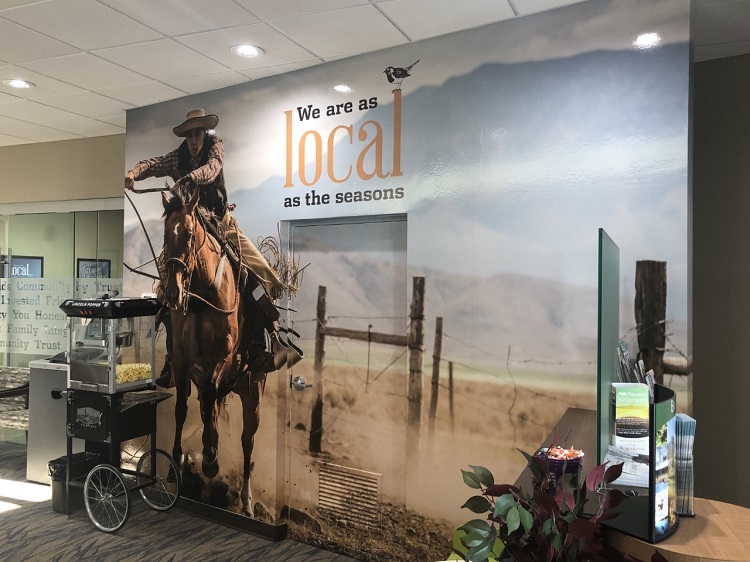Top-Level Takeaways
-
Branch profitability, location, demographics, and a deep understanding of the rural communities it serves all drive placement and expansion decisions for East Idaho Credit Union.
-
In one community, East Idaho’s branch has been the only banking center in town since the 1970s.
Celebrating its 85 anniversary, community-chartered East Idaho Credit Union ($309.6M, Idaho Falls, ID) serves more than 33,000 members across cities and towns that trace their heritage back to Old West wagon trails and river crossings.
The credit union is based in Idaho Falls, the state’s second-largest city boasting a metropolitan area population of 145,000, and from there operates nine branches serving a wide area. Its footprint encompasses urban and suburban cities along the Interstate 15-U.S. 20 corridor as well as remote towns in central-northern Idaho. In Arco, population 880, East Idaho is the only financial institution for miles. The credit union’s most remote branch is in Salmon, population 3,108, which is located more than 150 miles north of headquarters.
Across America, rural banks have been closing, driven in part by the growing use of mobile and digital banking services. Banks closed branches in rural counties at a rate of 14% between 2012 and 2017, with poor communities seeing a 50% decline in branches. In many towns, the loss of a branch means fewer visitors and less commerce.

Chris Cardwell, CFO, East Idaho Credit Union
East Idaho, however, is bucking that trend with an ongoing branch renewal and expansion program. In 2018, the credit union relocated a branch in Challis, population 1,088. It is opening a replacement branch in Rexburg, population 28,337, in April. And, it is set to break ground on a new branch in Pocatello, population 55,193, this spring.
According to Chris Cardwell, CFO of East Idaho, these capital decisions came down to branch profitability, location and demographic factors, and a deep understanding of the rural communities that rely on the credit union’s branch services.
We look at all of the dynamics of serving membership, Cardwell says. Certainly, digital is important to us, and as technology changes and we see more innovation, digital and remote access will be more and more important. But, I don’t think brick-and-mortar walk-in traffic is ever going to go away completely.
East Idaho’s service area stretches across fast-growing areas between Idaho Falls, the western entrance of Yellowstone National Park, and the rural farming communities of central Idaho. Although Idaho is ranked 39th in total population, it has been among the top 10 fastest-growing states since 2015, with Forbes naming Boise the nation’s fastest-growing area in 2018.
Serving Underserved Communities
East Idaho has acquired several smaller credit unions, and their branches, over the years and is committed to providing services to underserved areas, Cardwell says. Some of the credit union’s rural branches are staples in these small towns. The branch in Arco, which East Idaho remodeled in 2012, dates back to the 1970s and is the only banking center in town.

The Old West is engrained in the rural communities of central and eastern Idaho.
Located approximately 20 miles from the Idaho National Laboratory nuclear research center, Arco is best known as the world’s first city to be lit by nuclear power. Although the town’s population’s is only 880, more than 2,000 members use the branch. Members, including one of the credit union’s own board members, drive 30 miles or more to visit it.
These are small communities, Cardwell say. Our employees know the community members very well, so it’s more of a personal relationship. Oftentimes, members have digital and online banking but still come in and deposit full cashouts.
Branch Profitability And Lending
The credit union’s branch in Challis, a farming community between the Salmon River and rows of mountains ranges and national forest, dates back to 1985. It was operating in a rented space in a grocery store, but when East Idaho purchased land for a new branch, converting the lease to a capital asset made sense, Cardwell adds.
The credit union evaluates capital investments with a branch profitability model that considers the number of members using the branch, members’ savings and borrowing profiles, loan interest, interchange income, and fees. Looking at the ratio of savings-to-loans at each branch, Challis had a good track record of savings and was only 25% loaned out, compared with other branches in the east that were 100% loaned out.
That particular demographic has more savers than borrowers, Cardwell says. So, the extra deposit dollars there contribute to the funding of loans in other branches that are entirely loaned out.
Construction of the new branch included a groundbreaking with the Town Council and open house for the community.
It indicated to the community that we have a greater vested interest, the CFO says. We’re here to stay.
New Branch Design, New Locations
An update of the credit union’s brand provided the impetus to renew the look and feel of the branches, beginning six years ago with a major remodel of the main branch in Idaho Falls. The green and yellow logo, accented with a mountain skyline, is prominently displayed in the new branch design.
Like the Challis branch, the new branches in Rexburg and Pocatello are smaller in size, with three offices, cash machines, and a vault.
Those branches are almost identical in size and look and feel, Cardwell says. We are of the philosophy that you build smaller branches, and, if warranted, you put another branch in another location in the same city.

East Idaho is replicating a new design across its new branches.
Location is key. For example, the old branch in Rexburg was built 20 years ago near doctors’ offices south of town. The new branch is located just down the street from a Wal-Mart on the north side, which has significantly more retail traffic.
Most often, financial services are not a destination, Cardwell says. So, we need to make that brick-and-mortar more convenient to other businesses.
Launchpad For New Services
East Idaho’s branch network is also serving as a launchpad for additional services. For example, the credit union’s wealth management division uses the branches to schedule meetings with members to discuss investment services and retirement planning.
We want to manage the whole book of business for a member, Cardwell says.
As such, the credit union has plans to launch new business lending services. It is working with a third-party underwriter and gaining in-house expertise to launch business loans, which will compete with local banks for farm and cattle loans.
It will give us more diversification in our loan types, the CFO says. And we will be investing in a business that supports a significant part of the community.
Supporting The Community
Community support is another key success factor for East Idaho, which was awarded the Dora Maxwell Award for community service from the Credit Union National Association.
According to Cardwell, the credit union supports several high-profile charities. It hosts an annual golf tournament for Kicks for Kids and places empty water jugs in area schools between Thanksgiving and Christmas every year so students can donate their spare change to help purchase shoes for kids who need them. Last year, the program raised $49,560.
We have put thousands of shoes on kids’ feet through charitable donations, Cardwell says.
Planning For The Future
Although Pocatello will be East Idaho first new branch in years, Cardwell says the credit union will continue to look for new opportunities for expansion. The ideal expectation for return on investment, he said, is three to five years.
That’s when we’d like to be at a break-even standpoint, the CFO says. And, obviously, we want to look at the growth potential from then on.
Cardwell says he recently reviewed the statistics on credit union growth in Idaho, and noted that nearly every credit union in the state, regardless of size, has recently added a branch. That’s good for the residents of Idaho looking for a trustworthy FI.
There are e-financial services institutions out there with no brick-and-mortar that will supposedly give you a higher rate, but the trust factor is still not there with the population at large, Cardwell says. Financial institutions are here to stay. We need to keep abreast of innovative technologies, but we also need to focus on the needs of everyone on the planet.